A UK community that refuses to conform
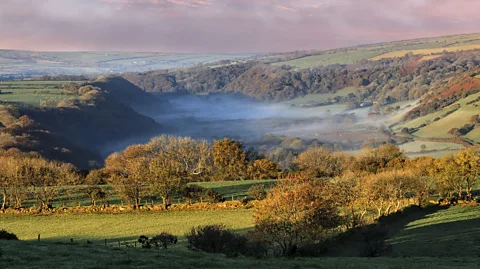 Birdsonline/Getty Images
Birdsonline/Getty ImagesIn Wales' rural Gwaun Valley, everything seems slightly out of sync, from pubs stuck in the Victorian era to New Year's Day being celebrated 13 days late.
The Gwaun Valley is a quiet, pastoral landscape that's markedly different than the rest of Wales. The steep-sided valley was shaped by geological convulsions in the form of strong and fast-moving water from melting glaciers during the last Ice Age, creating a fertile and abundant expanse of water meadows, flat floodplains and an ancient woodland that has long concealed Gwaun residents from sight.
Clusters of weathered stone cottages and traditional inns remain cut off from civilisation by steep, twisting roads and deep rivers interspersed with thick copses of trees. Until the invention of cars, these features dissuaded people from coming and going, leaving locals isolated and free to practice the many ancient rites that remain unique to the area.
"We're a funny lot… We stick to tradition," said Lilwen McAllister, owner of Erw-Lon Farm B&B which overlooks the valley. She's lived here for 54 years and confidently claims that the area's unique customs "will never die out".
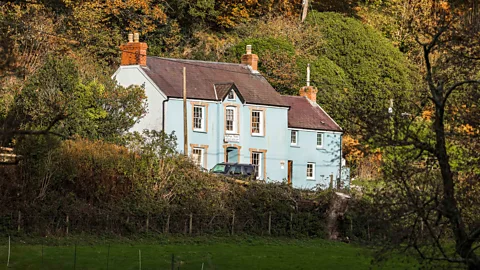 Jade Braham
Jade BrahamMcAllister, like the Gwaun's other 200-odd residents, bides her time until 13 January to ring in the New Year – known in Wales as Hen Galan (the old New Year) and referred to by locals as their "special day". The valley's residents are not a fortnight late; rather, they are one of the few remaining groups that continue to follow the old Julian calendar, named after Julius Caesar. The rest of the UK adopted the Gregorian calendar in 1752, which established New Year's Day as 1 January, but the Gwaun community refused to conform because they felt they were being cheated out of 11 days when the new calendar was adopted to correct the Julian's astronomical error.
The secluded, close-knit community has developed several other traditions to celebrate their start of the year, including parading horses' skulls on poles around the streets to offer blessings to their neighbours and partying the night away in one of Wales's most unusual pubs, the Dyffryn Arms.
I only live an hour away in Carmarthenshire but I've long been fascinated by this remote community that refuses to conform. So in late 2022, I decided to travel here to learn more about the origins of these unique customs and why the people of Gwaun are preserving them.
When I arrived, the Gwaun's landscape also felt like a different planet. The land had a powerful wildness, with walking trails used for thousands of years, and the valley's utter remoteness brought an air of mystery. The single-track roads that I ed on my way to Pontfaen, a small rural village that's considered the epicentre for the Julian festivities, were hemmed in by towering hedgerows that looked more like battlements than farmland. Beyond that were walls of vibrant and fertile hills.
I drove past the fallen leaves of oak and ash, holly and hazel in Allt Pontfaen. This ancient woodland has a rich lichen population that is of national importance, establishing the area as a Site of Special Scientific Interest (an area of rare flora and fauna) and putting Allt Pontfaen within a Special Area of Conservation (an area that protects special habitats or species).
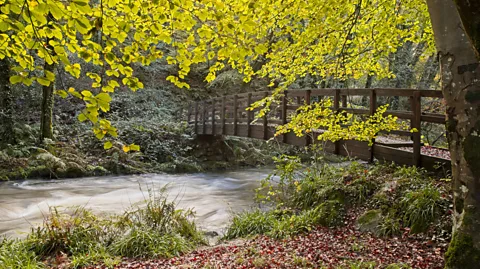 Birdsonline/Getty Images
Birdsonline/Getty ImagesThe River Gwaun ran parallel to my route, trickling beneath Pontfaen's entrance bridge and cutting the fields like a tectonic plate. Another relic of the Ice Age, the river is home to grey wagtails and dippers, and, according to author David Barnes in The Companion Guide to Wales, one of the last haunts of the otter. I didn't spot an otter, but a local gentleman offered warm salutations and, after a brief chat, suggested I head to the Dyffryn Arms – known locally as Bessie's Pub – to see the place where many spend their New Year's "for fireworks and drinks!".
Bessie's, which has been in the same family since 1840, is currently run by Bessie Davies, a nonagenarian who's been serving beer since her 20s. The tiny bar, which is, in fact, the front room of her home, features brown and black chequerboard tiles, a couple of church pews, wooden tables, a warming coal fire and international banknotes from visitors stuck to the walls. It's not only the pub's design that's a relic of the past. With no formal bar, Bessie and her family serve beer through a hatch in the wall, pouring straight from a barrel into a jug. Other than a few snacks, there's no food here – except on Hen Galan.
"Families come to the pub [in the evening] to have a few drinks, some food and to [have a] singsong," said Nerys Davies, Bessie's granddaughter. The festivities are never formally organised and, while the rest of Wales continues to work, the people of the Gwaun take an unofficial day off. They end it at Bessie's, where "everybody does his party piece… There will [always] be somebody there with a guitar and a keyboard," McAllister told me.
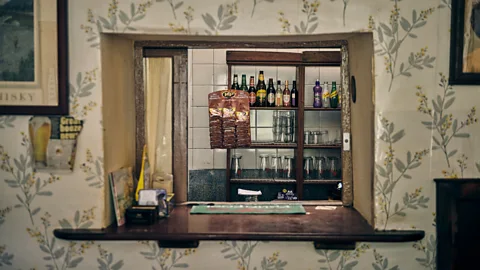 Hawlfraint y Goron / Crown copyright (2022
Hawlfraint y Goron / Crown copyright (2022The evening of Hen Galan starts when schoolchildren sing local songs such as Plant bach Cymru ydym nhi yn canu ein carolau (We are the children of Wales singing our carols). Indeed, Hen Galan is so important in Gwaun that local children are allowed a day off school. They start celebrating around 08:00, walking or driving for miles across the valley, from farm to farm, to follow the ancestral tradition of Calennig (Welsh for "the first day of the month" or "New Year celebration/gift") in a similar manner to trick-or-treating.
Having parked adjacent to Bessie's pub, I too began walking the undulating lanes. At which point, I realised how challenging it was to get to these remote dwellings. Yet come hell or high water – or several feet of snow – valley residents take to the road every year. Upon arrival at each house, the children serenade the owners with traditional Welsh songs that have a melody similar to Christmas carols:
Blwyddyn Newydd Dda i chi / A happy new year to you
Ac i bawb sydd yn y tŷ; / And to everyone in the house;
Dyma fy nymuniad i, / This is my wish,
Blwyddyn Newydd Dda i chi / A happy new year to you
The final line is often yelled in childlike excitement and the young visitors are given gifts of sweets, fruit or money to welcome the new year. Unlike trick-or-treating, the children are invited into the farmhouses, which, McAllister told me, "provide a feast… [serving things like] cold meats, chutneys, [and maybe] a trifle and piece of Christmas cake".
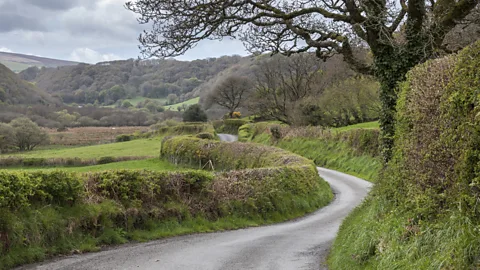 Photos by R A Kearton
Photos by R A KeartonAs I continued around the Gwaun Valley, I recalled McAllister singing the lyrics of another Hen Galan song: Mae dydd Calan wedi gwawrio (New Year's Day has dawned). It teaches that Hen Galan is a day to be generous, especially to the poor, much like another local New Year's tradition that sees individuals parading the skull of a horse – or a wooden replica – around houses and pubs, blessing those who open the door with good luck and fortune.
The horse is known as Mari Lwyd ("Grey Mare", in English). The tradition was first recorded in 1800, and, while no-one knows where it came from, many historians believe it to be of pagan or Celtic origin, favouring its connection with the pale horses in Celtic and British mythology who were able to to the underworld. It likewise follows the pre-Christian Welsh wassailing practices of going door to door, singing, making good wishes and communal drinking. While Bessie's pub doesn't participate in this custom, Davies said she has "heard people around here do", especially in the nearby Tafarn Sinc pub.
I learned that the Mari Lwyd skull is placed on a pole and covered with a white sheet, adorned with holly and ivy, ears, eyes and even a bridle made from cloth, ribbons and bells. Underneath stands a person manoeuvring the mouth so that it can snap open and closed like a horse neighing.
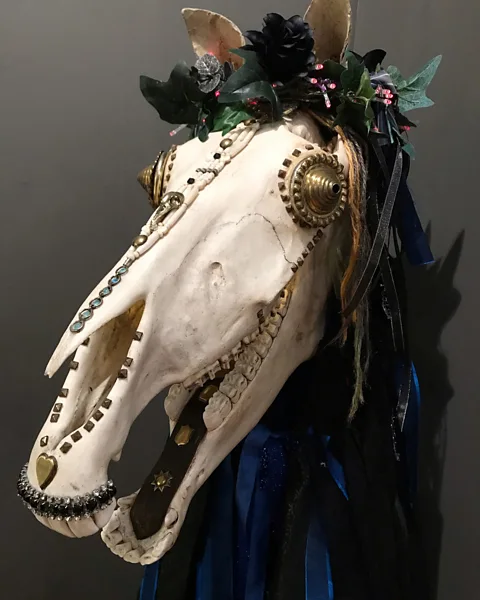 Hawlfraint y Goron / Crown copyright (2022
Hawlfraint y Goron / Crown copyright (2022Historically, Mari Lwyd engages in a battle of rhymes at each door, known as pwnco, with the household owners. If they cannot respond to Mari Lwyd's wit, the horse and its party must be invited inside as an act of "letting in" the coming year. Bardic tradition, which shares stories and songs in poem or verse form has always been important in Wales – as has singing, which also accompanies the horse around the houses. Today, the mystical Mari Lwyd s in with the New Year's merriments by entering local pubs and walking around the tables, at which point Welsh folk songs and instruments begin to play and can often be heard from miles away.
With such a secluded position and close-knit community, it's easy to see why ancient traditions have endured here. "Thank the lord the community hasn't changed over the years," McAllister said – and I'm sure this sentiment will be echoed for a long time to come.
Hidden Britain is a BBC Travel series that uncovers the most wonderful and curious of what Britain has to offer, by exploring quirky customs, feasting on unusual foods and unearthing mysteries from the past and present.
---
more than three million BBC Travel fans by liking us on Facebook, or follow us on Twitter and Instagram.
If you liked this story, sign up for the weekly bbc.com features newsletter called "The Essential List". A handpicked selection of stories from BBC Future, Culture, Worklife and Travel, delivered to your inbox every Friday.
